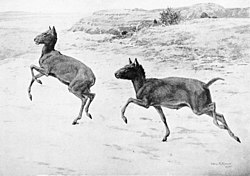| Thoatherium | |
|---|---|
 | |
| 1901 T. minusculum skeletal illustration | |
 | |
| 1913 T. minusculum illustration, by Charles R. Knight. | |
| Scientific classification | |
| Domain: | Eukaryota |
| Kingdom: | Animalia |
| Phylum: | Chordata |
| Class: | Mammalia |
| Order: | † Litopterna |
| Family: | † Proterotheriidae |
| Subfamily: | † Proterotheriinae |
| Genus: | † Thoatherium Ameghino 1887 |
| Type species | |
| †Thoatherium minusculum Ameghino, 1887 | |
| Species | |
| |
| Synonyms | |
Genus synonymy
T. minisculum
| |
Thoatherium (meaning "active swift-beast") is an extinct genus of litoptern mammals from the Early Miocene of Argentina. Fossils of the genus have been found in the Santa Cruz Formation in Argentina. [1]









